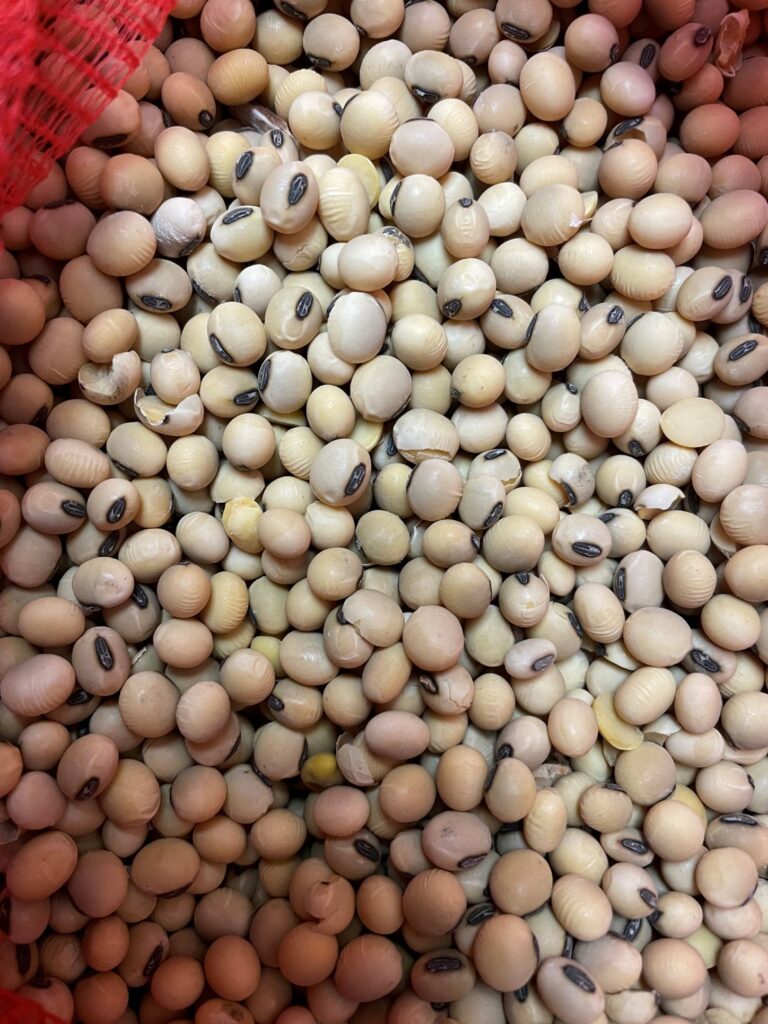The precise yield of a soybean field is notoriously difficult to predict before harvest. This is because seed size can vary by over 30 percent and zones within a field can have drastically different yields depending on soil water holding capacity, disease pressure, topography, etc. Plants with low pod number and combine harvest losses also add to the inaccuracy of yield estimates. Estimates can be made as early as the R5 growth stage but become much more accurate at the R6 stage and later. An estimate of yield can be made once the following criteria are known:
- Number of plants per acre. Choose at least 5 locations in a field to determine the number of plants per acre. To calculate plants per acre, count the number of plants in 1/1,000th of an acre. In 7.5-inch row spacing, count the number of plants in 69 feet, 8 inches of row. In 15-inch row spacing, count the number of plants in 34 feet, 10 inches of row. In 30-inch row spacing, count the number of plants in 17 feet, 5 inches of row. Multiply this number by 1000 to get the number of plants per acre. Alternatively, the hoop method can be used to estimate the number of plants per acre. This method is preferred in solid-seeded stands. (7.5 inch row spacing)
- Number of pods per plant. On 10 consecutive plants, count the number of pods. Divide the number of pods by 10 to calculate the average number of pods per plant. It is easy to “overcount” the number of seed-bearing pods per plant. Make sure to use 10 consecutive plants, not only good plants. Do not count small or very immature pods at the top of the plant.
- Number of seeds per pod. Either count the number of seeds per pod of at least 30 pods and take an average. Or, instead of counting the seeds per pod, use a value of 2.4 seeds/pod.
- Seed size (weight). An average seed weight can be found on the back of the seed bag or at Gosoy.ca. If there is no information available, a value of 2,900 seeds/lb can be used as an conservative approximate value.
- A standard weight of 60 lbs/bu is used for soybeans.
Estimate yield potential (bu/ac) using the following formula:
(plants/acre X pods/plant X seeds/pod) (seeds/pound)
(pounds/bushel) = average bushels/acre
Example of calculating yield potential using realistic average Ontario values:
135 000 plants/acre X 32 pods/plant X 2.4 seed/pod = 10 368 000 seeds/acre
10 368 000 seeds/acre 2900 seeds/pound = 3575 pounds/acre
3575 pounds/acre 60 pounds/bushel = 59.6 bu/ac
It’s important to know that yield estimates typically overestimate the actual harvested field average attained at harvest. There are often parts of a field that are much lower in yield which brings down the field average. Keep in mind that the 5 year provincial average in Ontario is approximately 50 bu/ac, and should therefore be considered a “normal” yield. Combine losses can decrease harvested yield significantly. Typical harvest losses range from 1-2 bu/ac but can be much higher. Take at least 2 bu/ac off the estimated yield to get a better harvested field average estimate. Overestimating the number of seed-bearing pods/plant and seeds/pod also quickly exaggerate yield estimates. The more representative these numbers are, the better the final yield estimate will be. Do at least 5 estimates in different parts of a field and take an average. The percentage of shriveled, cracked, or small seeds will also lower final tonnage, see figure 1, Soybean Seed Sample at Harvest.

Figure 1. Soybean Seed Sample at Harvest. A typical soybean sample at harvest will contain various seed sizes, cracked seed coats, poor quality, as well as good seed.